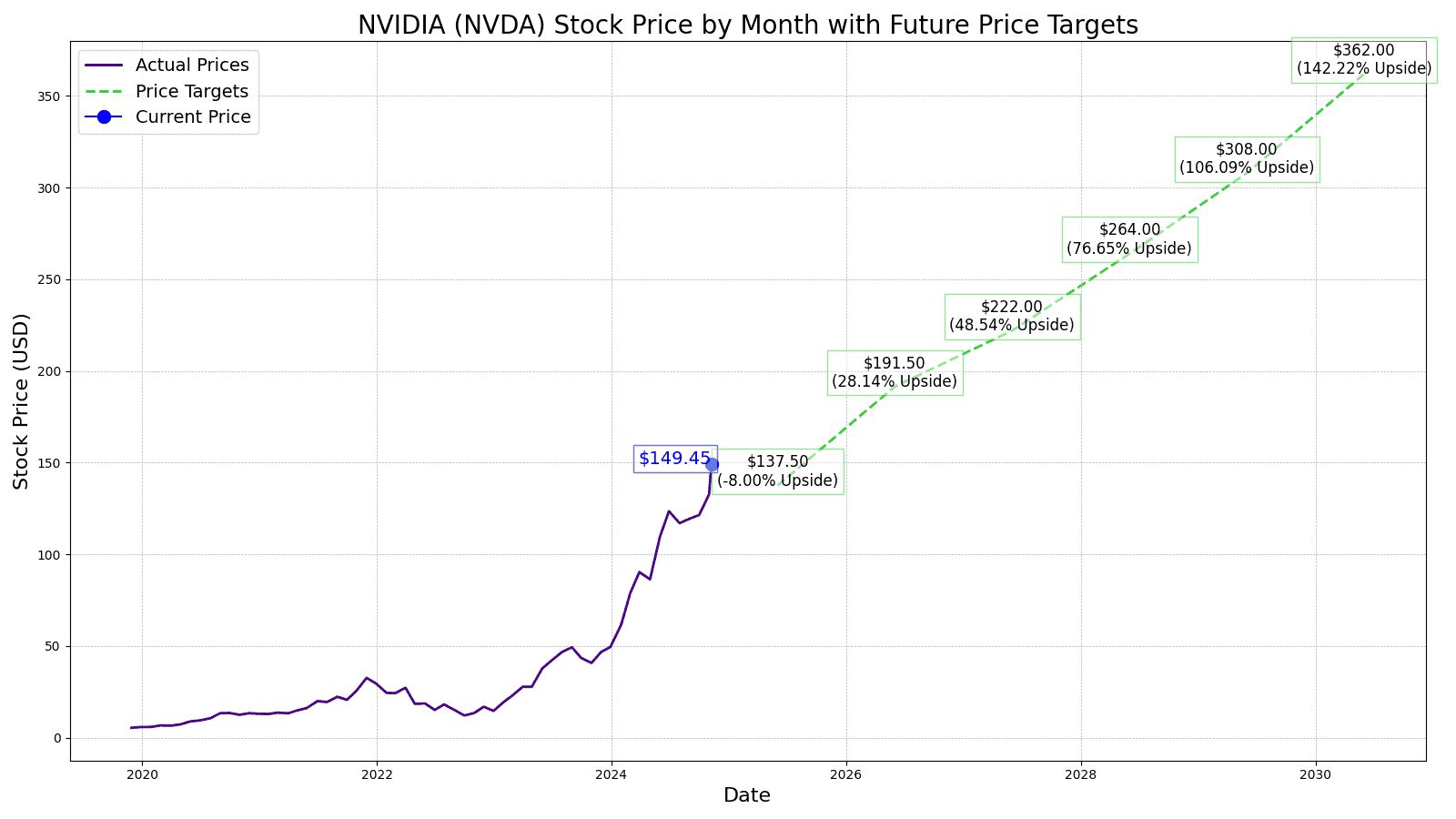
The artificial intelligence-fueled rally has been the foremost contributor to the major market indices’ sizable gains over the past several years. And one company in particular is at the vanguard: NVIDIA Corp. (NASDAQ: NVDA). NVIDIA is the premier manufacturer of components critical to the surge in AI; namely, semiconductors, microchips, and graphics processing units (GPUs).ca
As a result, the Santa Clara, Calif.-based company has seen its stock skyrocket in the recent past. Since the first day the market opened in 2023, shares have gained 919.03%, and in the decade from August 2014 to present, they are up a preposterous 31576.60%. In June 2024, NVIDIA underwent its sixth stock split, further fueling demand for its shares as the company surged upward and is now the second largest by market cap.
Despite those mind-boggling gains, analysts still expect enormous upside potential in the medium and long term. 24/7 Wall Street has performed analysis to provide prospective investors and current shareholders with an idea of where NVIDIA’s stock might be headed over the course of the next five years.
Key Points in This Article:
- NVIDIA’s track record of strong earnings suggests an ability to remain at the forefront of its industry, as competitors fight for the leftovers.
- Between NVIDIA’s client list of Magnificent Seven companies and the burgeoning trend in AI, growth in both revenue and net income is projected to continue its steep climb.
- If you’re looking for a megatrend with massive potential, make sure to grab a complimentary copy of our “The Next NVIDIA” report. This report breaks down AI stocks with 10x potential and will give you a huge leg up on profiting from this massive sea change.

NVIDIA News and Updates
11/8/2024
Nvidia has officially joined the Dow Jones Industrial Average. Nvidia’s stock price has risen by about 9% this week, surpassing Apple as the world’s most valuable company.
11/7/2024
The Federal Reserve delivered a 25 basis point interest rate cut today, bringing its benchmark rate down to a range of 4.5% to 4.75%. The market reacted positively to the news, with shares of Nvidia hitting new all-time highs.
11/6/2024
Several stocks surged on Wall Street today following the U.S. presidential election. Nvidia hit a record high, solidifying its position as the world’s most valuable company with a market capitalization of $3.58 trillion.
11/5/2024
Nvidia has claimed its position as the world’s most valuable publicly traded company, surpassing Apple. This surge in valuation is the result of an unprecedented demand for the company’s high-performance graphics processing units (GPUs), which are essential for powering artificial intelligence and machine learning applications.
11/4/2024
Nvidia will be added to the Dow Jones Industrial Average, replacing Dow Inc. (DOW), effective before the market opens on November 8th.
11/1/2024
Nvidia is developing a new type of chip that combines both a CPU and a GPU on a single chip. This new chip is designed to power consumer PCs, competing directly with Qualcomm’s Snapdragon X series.
10/31/2024
Nvidia’s stock price decreased 4% today. The decrease follows the European Commission’s announcement that the company’s proposed acquisition of AI startup Run requires EU antitrust clearance due to potential competition concerns.
10/29/2024
Nvidia has introduced enterprise reference architectures (RAs) to assist businesses in streamlining their infrastructure strategies. These RAs serve as blueprints to help Nvidia’s partners and their customers construct “AI factories”, high-performance data centers optimized for AI workloads.
10/28/2024
Nvidia is holding strong in its battle against Apple to become the world’s most valuable company. Today, the stock is rising slightly, bringing it closer to the title.
10/25/2024
Several AI chip stocks, including Nvidia, rose today due to positive analyst reports from Wall Street.
NVIDIA’s Recent Stock Success
Unless you have been living under a rock, chances are you have caught wind of the very well-documented and rather exponential surge in NVIDIA’s share price since 2022. But before 2022’s price-per-share explosion, it was steadily appreciating as it underwent a series of stock splits.
| Year | Share Price* | Revenue** | Net Income** |
| 2014 | $0.51 | $4.130 | $0.588 |
| 2015 | $0.82 | $4.681 | $0.800 |
| 2016 | $2.67 | $5.010 | $0.929 |
| 2017 | $4.88 | $6.910 | $1.851 |
| 2018 | $3.24 | $9.714 | $3.085 |
| 2019 | $5.98 | $11.716 | $4.143 |
| 2020 | $13.06 | $10.918 | $3.580 |
| 2021 | $29.64 | $16.675 | $6.277 |
| 2022 | $14.61 | $26.914 | $11.259 |
| 2023 | $49.52 | $26.974 | $8.366 |
*Post-split adjusted basis
**Revenue and net income in $billions
Over the course of the last decade, NVIDIA’s revenue grew by more than 553% while its net income increased by just over 1,323%. The company experienced a slight contraction in revenue and net income in 2020 due to the COVID-19 pandemic, but it rebounded soundly the following year and has continued to steadily grow both metrics since. Meanwhile, shares were able to increase by 9,610% from 2014 to 2023.
As the AI lynchpin looks forward to the second half of the decade, 24/7 Wall Street has identified three key drivers that are likely to impact its growth metrics and stock performance through 2030.
Key Drivers of NVIDIA’s Stock Performance
- Stronghold on the GPU Industry: No one makes GPUs like Nvidia makes GPUs, and the industry demanding them is well aware of that. While semiconductor competitors like Advanced Micro Devices Inc. (NASDAQ: AMD) and Taiwan Semiconductor Manufacturing Company Ltd. (NYSE: TSM) do command some attention in their respective corners of the market, simply comparing the three companies’ market caps demonstrates the discrepancies between NVIDIA and, well, every other company. While Advanced Micro Devices and Taiwan Semiconductor Manufacturing have respectable market caps of $242.80 billion and $857.18 billion, respectively, those are dwarfed by NVIDIA’s $3.62 trillion.
- Demand From Unrivaled Tech Customers: The company’s primary clientele are the other members of the Magnificent Seven, which are leading the way forward in the AI revolution. In fact, only four Big Tech rival companies — Alphabet Inc. (NASDAQ: GOOGL), Amazon.com Inc. (NASDAQ: AMZN), Meta Platforms Inc. (NASDAQ: META), and Microsoft Corp. (NASDAQ: MSFT) — account for 40% of NVIDIA’s revenue as they vie with one another to become the front runner of the transition to generative AI.
- The AI Trend Is Just Getting Started: According to Grand View Research, the market size of AI in 2023 was $196.63 billion. As large as that seems, it pales in comparison to where the market is headed. From 2024 to 2030, it is expected that the industry will grow at an astounding compound annual growth rate (CAGR) of 36.6%, with “continuous research and innovation directed by tech giants [that] are driving adoption of advanced technologies in industry verticals, such as automotive, healthcare, retail, finance, and manufacturing,” according to Grand View Research’s report.

NVIDIA (NVDA) Price Prediction in 2025
The current consensus median one-year price target for NVIDIA, according to analysts, is $150.00, which represents a nearly 0.75% potential upside over the next 12 months based on the current share price of $148.88. Of all the analysts covering NVIDIA, the stock is a consensus buy, with a 1.3 ‘Buy’ rating on a scale from 1 (‘Strong Buy’) to 5 (‘Strong Sell’).
However, by the end of 2025, 24/7 Wall Street‘s forecast projects shares of NVIDIA to be trading for $137.50 based on a projected EPS of $2.75 and a price-to-earnings (P/E) ratio of 50, with a best-case scenario of $192.50 per share and a worst-case scenario of $82.50 per share.
NVIDIA (NVDA) Stock Forecast Through 2030
| Year | Revenue* | Net Income* | EPS |
| 2025 | $121.255 | $68.392 | $2.75 |
| 2026 | $168.151 | $95.246 | $3.83 |
| 2027 | $193.852 | $108.182 | $4.44 |
| 2028 | $225.462 | $130.155 | $5.28 |
| 2029 | $236.498 | $152.001 | $6.16 |
| 2030 | $265.522 | $175.412 | $7.24 |
*Revenue and net income in $billions
How NVIDIA’s Next Five Years Could Play Out

At the end of 2025, we expect to see revenue, net income and EPS rise 99%, 111.66%, and 111.54%, respectively. That would result in a share price of $137.50, or -7.64% higher than where the stock is currently trading. Our high-end price target is $192.50, while our low-end price target is $82.50.
When 2026 concludes, we forecast NVIDIA’s revenue to be $168.151 billion resulting in a net income of $95.246 billion. That year would end with a per-share price of $191.50, representing a gain of 28.63% compared to its share price today. Our high-end price target is $268.10, while our low-end price target is $114.90.
When 2027 concludes, we forecast NVIDIA’s revenue to be $193.85 billion resulting in a net income of $108.182 billion. That year would end with a per-share price of $222.00, representing a gain of 49.11% compared to its share price today. Our high-end price target is $310.80, while our low-end price target is $133.20.
When 2028 concludes, we forecast NVIDIA’s revenue to be $225.462 billion resulting in a net income of $130.155 billion. That year would end with a per-share price of $264.00, representing a gain of 77.32% compared to its share price today. Our high-end price target is $369.60, while our low-end price target is $158.40.
When 2029 concludes, we forecast NVIDIA’s revenue to be $236.498 billion resulting in a net income of $152.001 billion. That year would end with a per-share price of $308.00, representing a gain of 106.88% compared to its share price today. Our high-end price target is $431.20, while our low-end price target is $184.40.
NVIDIA Stocks Price Target for 2030
By the conclusion of 2030, 24/7 Wall Street estimates that NVIDIA’s stock will be trading for $362.00, good for a 143.15% increase over today’s share price, based on an EPS of $7.24 and a P/E ratio of 50. Our high-end price target is $506.80 based on an EPS of $7.24 and a P/E ratio of 70. Meanwhile, our low-end price target is $217.20 based on an EPS of $7.24 and a P/E ratio of 30.
| Year | Price Target | % Change From Current Price |
| 2025 | $137.50 | -7.64% |
| 2026 | $191.50 | 28.63% |
| 2027 | $222.00 | 49.11% |
| 2028 | $264.00 | 77.32% |
| 2029 | $308.00 | 106.88 |
| 2030 | $362.00 | 143.15% |
Thank you for reading! Have some feedback for us?
Contact the 24/7 Wall St. editorial team.



